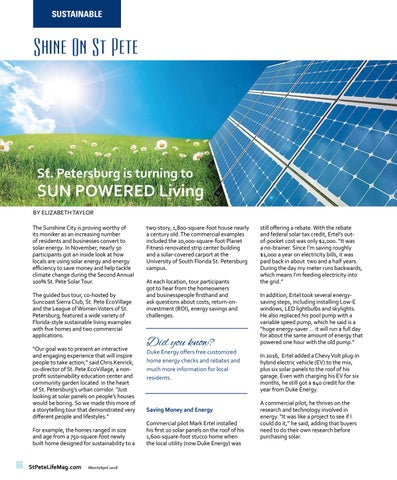SUSTAINABLE
Shine On St Pete
St. Petersburg is turning to
SUN POWERED Living BY ELIZABETH TAYLOR The Sunshine City is proving worthy of its moniker as an increasing number of residents and businesses convert to solar energy. In November, nearly 50 participants got an inside look at how locals are using solar energy and energy efficiency to save money and help tackle climate change during the Second Annual 100% St. Pete Solar Tour. The guided bus tour, co-hosted by Suncoast Sierra Club, St. Pete EcoVillage and the League of Women Voters of St. Petersburg, featured a wide variety of Florida-style sustainable living examples with five homes and two commercial applications. “Our goal was to present an interactive and engaging experience that will inspire people to take action,” said Chris Kenrick, co-director of St. Pete EcoVillage, a nonprofit sustainability education center and community garden located in the heart of St. Petersburg’s urban corridor. “Just looking at solar panels on people’s houses would be boring. So we made this more of a storytelling tour that demonstrated very different people and lifestyles.” For example, the homes ranged in size and age from a 750-square-foot newly built home designed for sustainability to a
66
StPeteLifeMag.com
March/April 2018
two-story, 1,800-square-foot house nearly a century old. The commercial examples included the 20,000-square-foot Planet Fitness renovated strip center building and a solar-covered carport at the University of South Florida St. Petersburg campus. At each location, tour participants got to hear from the homeowners and businesspeople firsthand and ask questions about costs, return-oninvestment (ROI), energy savings and challenges.
still offering a rebate. With the rebate and federal solar tax credit, Ertel’s outof-pocket cost was only $2,000. “It was a no-brainer. Since I’m saving roughly $1,000 a year on electricity bills, it was paid back in about two and a half years. During the day my meter runs backwards, which means I’m feeding electricity into the grid.” In addition, Ertel took several energysaving steps, including installing Low-E windows, LED lightbulbs and skylights. He also replaced his pool pump with a variable speed pump, which he said is a “huge energy-saver … it will run a full day for about the same amount of energy that powered one hour with the old pump.” In 2016, Ertel added a Chevy Volt plug-in hybrid electric vehicle (EV) to the mix, plus six solar panels to the roof of his garage. Even with charging his EV for six months, he still got a $40 credit for the year from Duke Energy.
Saving Money and Energy Commercial pilot Mark Ertel installed his first 20 solar panels on the roof of his 1,600-square-foot stucco home when the local utility (now Duke Energy) was
A commercial pilot, he thrives on the research and technology involved in energy. “It was like a project to see if I could do it,” he said, adding that buyers need to do their own research before purchasing solar.
